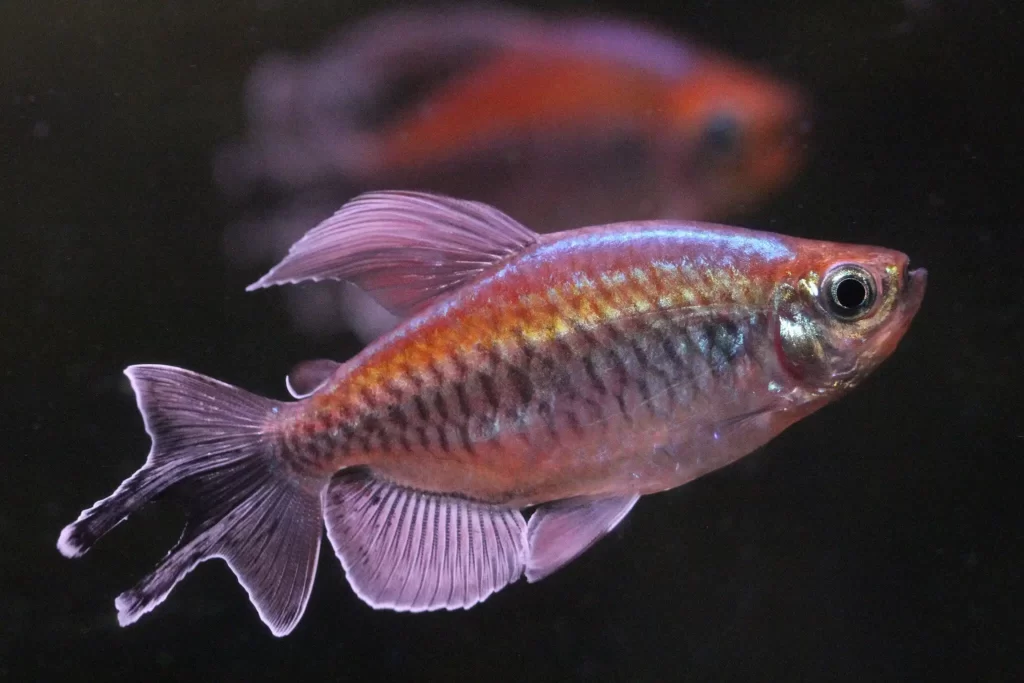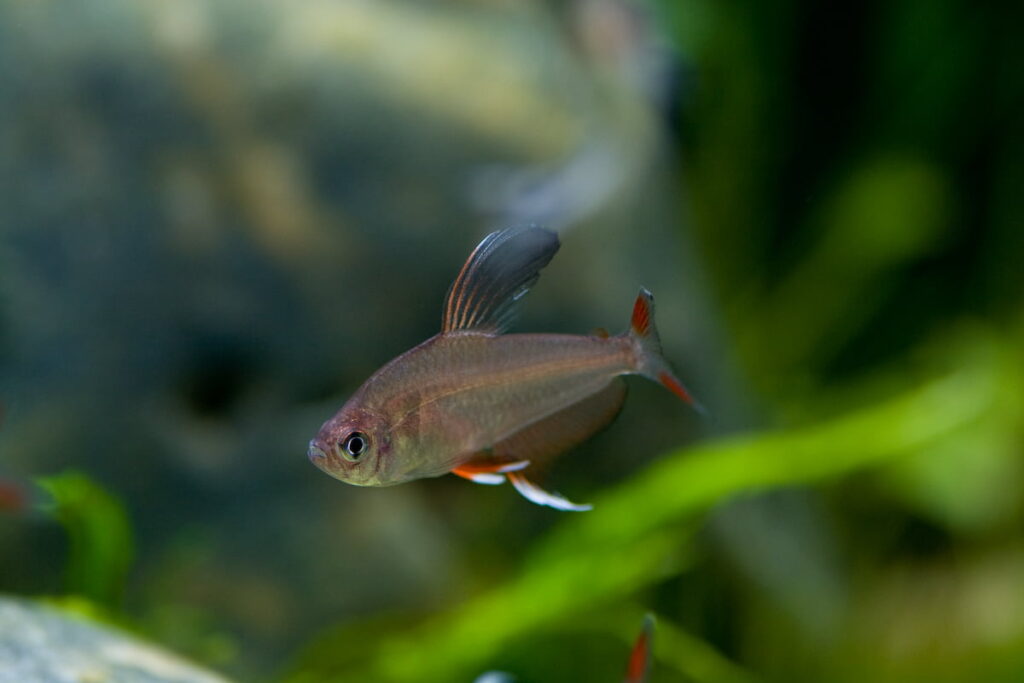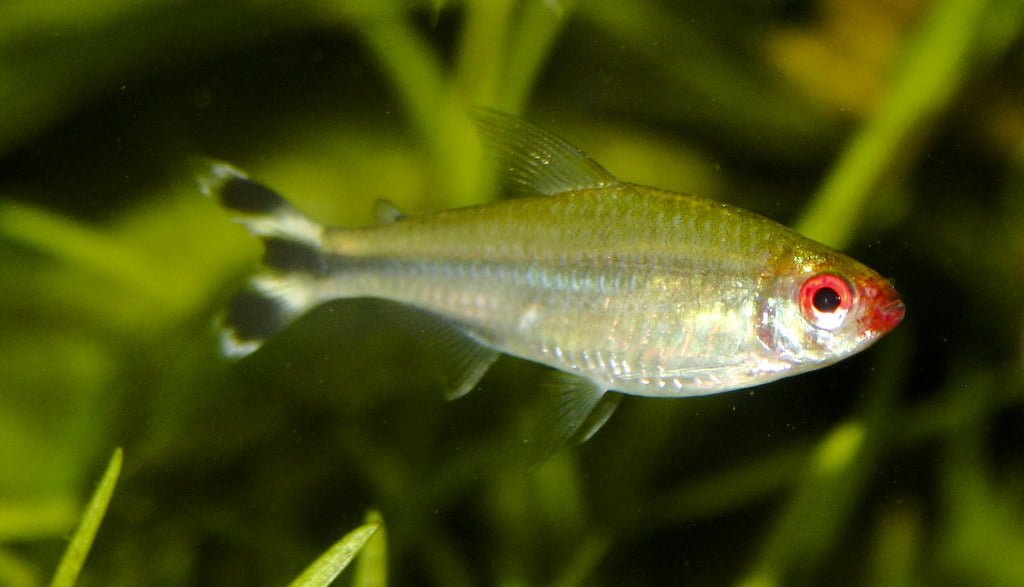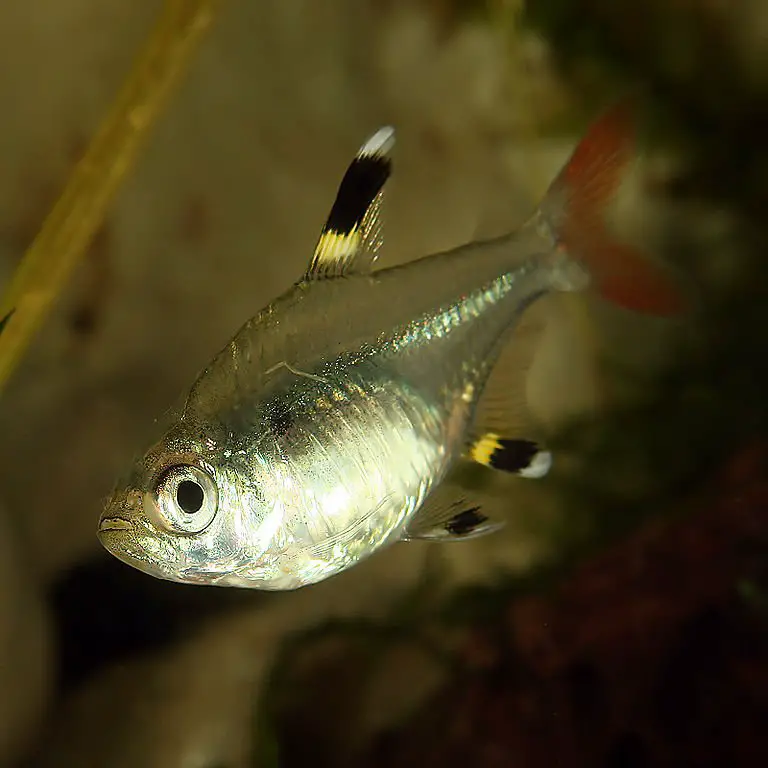Silvertip Tetras (Hasemania nana) are gorgeous and active shoal community fish. They are called Silvertip Tetra because of their shimmering white and silver color on the tip of its fins. Silvertip Tetras are a peaceful fish that is ideal for a community aquarium. However, it can show a little bit of aggressiveness when kept alone. They can be found in the freshwater of South America, Sao Francisco basin in Brazil, which is native to the rivers and streams.
Silvertip Tetras are hardy and quite colorful fish that accept a wide range of water parameters and best for the beginner aquarists. They love to be in a school of the same species of fishes which is mostly a group of six or more. Somehow some people might find it difficult to keep them in the home aquarium because of their little bit aggressive behavior, which often happens if you keep them with other long-fin fish.
Since the fish is so popular, there are so many breeding facilities around the globe. And most probably the fish you find your pet store is a captive bred one rather than the wild-caught. However, you will not find any differences with its overall body structure and color.
In this article, you will find all the necessary information regarding the Silvertip Tetra. If you are a beginner and planning to buy a Silvertip Tetra and don’t know anything about it then, this article will be lifesaving for you. I will explain complete necessary information regarding its tank mates, aquarium care, diet, breeding, fry care.
So, first of all, let’s begin with the origin of Silvertip Tetra.
Origin and Habitat in the Wild
Silvertip Tetra originates from South America and Sao Francisco in Brazil. They belong to the Ray-finned (Actinopterygii) class and Characidae family, which are first classified by Ltken in 1875. Still, they are recognized as the most beautiful tetra for the aquarium. These species of tetras are not listed on the IUCN Red List, which is good news for the aquarist.
Silvertip Tetras are tropical freshwater fish that tend to inhabit in both brackish and freshwater in the wild, which differs from other species of tetras. Silvertip Tetra tributaries away from the main river channels, where there is slow-moving water with a higher abundance of food.
Mostly, Silvertip Tetra lives with the other small species of fishes which are generally peaceful and quiet.
Distribution of Silvertip Tetra
Silvertip Tetras, also known as Copper tetra, are so popular in the market because of its beautiful golden body and silver-tip in its fin. Most of the beginner’s aquarist wants to buy original Silvertip Tetra which is from its natural environment. But sadly, most of the breeds that are found in the local store are captive rather than natural caught. However, there isn’t any difference in their body or coloration.
Due to its high demand in the market, most of the Silvertip Tetras are distributed from the Rio Sao Francisco, Brazil, to different countries.
Characteristics of Silvertip Tetra
Scientific name: Hasemania nana
Family: Characin
Class: Actinopterygii
Silvertip Tetra Maximum size: 5cm / 2 inches
Behavior: Peaceful and Active
Lifespan: 5 to 8 years (if cared properly)
Color: Golden with silver-tip fin
Diet: Omnivores (can eat both plant and live food)
Environment: Freshwater
Group Behavior: School
Age of Sexual Maturity: 5 – 8 months
Experience Level: Beginners who have a little knowledge about fish
Breeding: Normal, Egg Layer
Temperature: 24C to 28C / 72 to 82F
pH value: 6.0 to 8.0
Hardness condition: 2 to 15dGH (recommended)
Fish Description (Silvertip Tetra)
Silvertip Tetras are small size tropical fish that mostly live in freshwater. They will generally reach up to about 2 inches (5cm) in length, which looks beautiful with their gold and silver combination body. The average life span of Silvertip Tetra is about 5 to 8 years or can be even longer if you take care of it properly.
They are active community fish, which are called by various names such as Kobbertetra, Kupfersalmler, Tipped tetra, and Copper tetra.
Let’s get into a detail description of Silvertip Tetra.
Appearance / Color and marking of Silvertip Tetra
Most of the people buy Silvertip Tetra because of their appearance.
The body of Silvertip Tetra is almost golden; you can see a little bit of silver pattern beside the eyes. Silvertip Tetra has a black stripe that goes from the middle of the body to the end of the tail fins. The dorsal fin has a golden-yellowish color with a little bit of silver on the tip. The anal fin has quite a similar color to the dorsal fin. However, this species of tetra does not have an adipose fin compare to other species of tetra. Talking about the Tail fin, they have a little bit of silver lining at the end of the left and right side of the fin.
All these marking and stunning colorations make Silvertip Tetra more famous for the home aquarium.
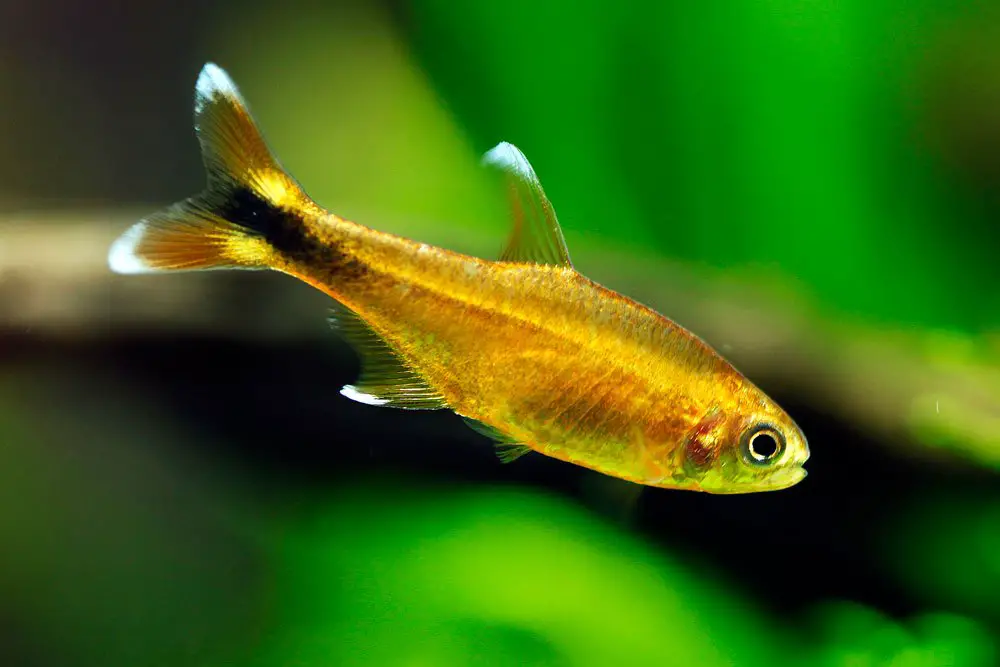
Silvertip Tetra Personality
Silvertip Tetras are peaceful schooling fish; they love to be in a group of at least six or seven.
Silvertip Tetras are peaceful schooling fish that are active and loves to be with other small non-aggressive species of fish such as livebearers, danios, rasboras, and other tetras. Besides that, these tetras can nip the fin of different species of fish if you keep them alone in the aquarium. But keeping them in groups of 6 or more can reduce the problem of fin nipping.
Silvertip Tetras are egg scatterers; they lay eggs on plants.
The adult Silvertip Tetra does not care about its egg or the fry; they will eat it if they find it. So, if you are trying to breed Silvertip Tetra, you should keep them in a separate tank after the breeding.
Sexual Difference
If you are a beginner and do not know how to differentiate male and female tetra, then it’s so simple.
- Male Silvertip Tetra has a coppery color while female tetras are grey combine with yellow-tipped anal fin.
- Mature females have a slightly bigger belly than male tetras.
Fish Keeping Difficulty
Most of the beginners will get confused about how to care for a fish after buying them for their aquarium. They do not know anything about the fish. Due to this reason, they will change their minds regarding fish keeping.
But, keeping Silvertip Tetra will not be so complicated than you think.
They are very peaceful and rarely aggressive species of tetra that will do well in the aquarium. If you maintain all the necessary things which I explain in this article, then you can keep Silvertip Tetra without any worries.
Silvertip Tetra Fish Care
Do you love small aquarium fish?
Everybody loves!!
These small species of fish look so amazing when they move around the aquarium in a group. This is also one of the reasons that attract most of the people.
Some people are so passionate about fish keeping that they buy a fish for the home aquarium as their hobby. They care for the fish and tries to replicate their natural environment on their aquarium.
However, in most of the case, people buy fish to entertain themselves. They don’t do any research, do not cares for what fish require, fill up the aquarium, and dumps the poor little soul in their aquarium. And in the next few days or weeks, they end up dying.
Fish also need proper care, just like a human. Without attention, you might see them floating in the aquarium. DEAD!!
So, do a little research about the fish before even buying a tank for the fish you are planning to keep.
Silvertip Tetras are hardy fish that accept the wide range of water parameter and good for beginners, who has a little knowledge about how to maintain water parameter.
If this information still does not go through your mind, then read the whole article, and you will have an idea about their requirements. So that it will be easy for you to take care of them inside your aquarium, and they can live a happy life.
An aquarium is a closed system, just like your septic tank in your home. If you do not maintain your aquarium water, it will slowly convert into toxic water that is not good for your fish. This is a serious problem that you do not want to happen in an aquarium. Therefore, always remember to change at least 10% of your aquarium water every week to eliminate the toxins.
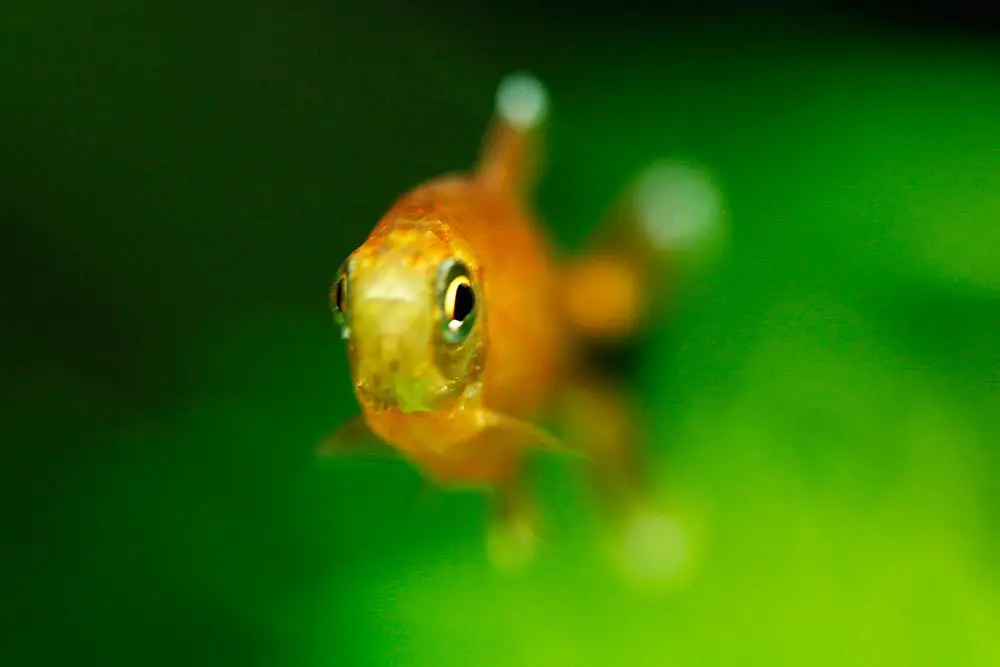
Note: Tank size, water temperature, water hardness, pH level, Aquarium Nitrogen Cycle plays a vital role in keeping your aquarium water fish safe.
I have explained all those caring factors of Silvertip Tetra down below.
Tank Size for Silvertip Tetra
Most of the beginners make a mistake choosing an aquarium. The first thing you should remember is that you should buy a tank that is a bit bigger than what your fish requires. If you are keeping the groups of fishes, then obviously them will need a bigger tank.
As Silvertip Tetras are schooling fish, they do best in a group of at least six, which requires bigger and free space to swim around the tank freely. This will make them feel comfortable, just like in their natural habitat.
One inch of fish requires 2-Gallons of water to survive. Let’s Suppose you buy young Silvertip Tetra that’s 1/2 inch. It will definitely get big, right? Silvertip Tetra grows up to 1.5 inches so, one adult tetra requires 3 gallons of water. If my calculation is correct, six of these tetras need 15-20 gallons of water to live happily.
If you are planning to get more of these tetras, then you should go for a bigger tank. This will poop their color more, and you will be able to see their schooling behavior that is stunning to watch.
Lightning in the Aquarium
Another essential part of caring Silvertip Tetra is lightning. Dim lighting will be best for your tetra. Even though your aquarium looks a little bit dark due to the dim lighting, you can easily see the Silvertip Tetra because of their shining body that looks stunning in the aquarium when they reflect the light.
Besides that, the Silvertip Tetra color will show up better in the dark substrate, which looks spectacular in the aquarium.
Lighting is necessary not only for fish but also for aquatic plants for the photosynthesis process, which helps to grow the plants even better. However, dim lighting will not work for the plants. So, if you are planning to plant your aquarium, buy a light that is suitable for the plants. Silvertip Tetras are from the river basin where a minimal amount of light penetrates due to this reason bright light can cause stress to the fish. However, when you are adding aquarium plants, it creates a lot of hiding places for your fish to hide.
Water Quality
A suitable water parameter is essential for the fish to survive.
Some people do not change their aquarium water for months, which causes fish diseases such as fin rot, white spot disease, velvet disease and can also lead to fish death. Likewise, fluctuation in temperature can bring fish to stress as they are cold-blooded animals.
Even if your water is clear, it might be toxic for your fish if you don’t do water change quite often. You should maintain your water quality by maintaining the pH, hardness, Ammonia, Nitrite, Nitrate, Phosphate level in your aquarium.
Are you still confused?
Let’s go even further to know the water quality for Silvertip Tetra.
Water Temperature
The water temperature of the aquarium should be properly balanced according to season. Since fish are cold-blooded animals, they will get more comfortable if you maintain the water temperature carefully.
Silvertip Tetra will do best in temperature of 72F to 82F (23 to 28C) that will help them to feel just like in its natural habitat.
Note: Installing a high-quality automatic water heater can save a certain amount of bucks on the electricity bills. And will also automatically set the water temperature that you set in the heater.
Water pH level and Hardness
Silvertip Tetras live brackish water as well as in freshwater. So, they can tolerate a wide range of water pH levels. If you maintain the pH level of 6.0 to 7.8, including the hardness of 5 to 10H, then Silvertip Tetra will not find any difficulty.
Note: If your water pH level is more than 8.5, than try adding some aquarium salt or sea salt in the water that will balance the water.
Water Filtration
Let’s suppose you are going on a vacation. After a couple of days, you came back home and saw your aquarium filled with green type fungus or algae with some dead fish.
Nobody wants to see that in the aquarium right. So, a good quality aquarium filter is a must to keep in your aquarium to maintain the aquarium water.
Aquarium filter is a helping hand when it comes to maintaining the quality of water. It will not only filter and cleanse the aquarium water but will also help in the Aquarium Nitrogen Cycle.
The beneficial bacteria like Nitrifying bacteria and Nitrobacter bacteria help to breakdown ammonia and nitrite that are very toxic to your aquarium water. These bacteria help to keep the water fish safe.
Tip: Buy an aquarium filter that has all the stages of the filtration process and is big. A bigger filter will have a bigger volume to house all your filter media and beneficial bacteria.
A good aquarium filter will have, Mechanical filter media, chemical filter media and biological filter media on it.
You should still change the aquarium water once in a week to eliminate nitrogen or the organic waste in your aquarium.
Aquarium Substrate and Decorations
For small fish like Silvertip Tetra, you can either use fined gravel, sand, or soil as a substrate in the aquarium. Using sand as a substrate will help resemble their natural habitat and is cheap as well. However, I will recommend using soil as a substrate because Silvertip Tetra looks stunning in a planted aquarium. The soil will not only help to grow the plant but will also help to maintain water pH.
Silvertip Tetra’s body pops its color in a darker tank, and adding soil in your aquarium will darken your aquarium a little bit as it doesn’t reflect any light.
In nature, fish live in a water stream where there is plenty of plants and rocks. If you want to decorate your aquarium, just like in a natural environment, then add some plants, rocks from the river, and driftwoods in your aquarium.
Aquarium plants will also help to oxygenate the water, which maintains the flow of oxygen inside the aquarium. This will be beneficial for your fish as well.
Sometime tetras feel uncomfortable with other species of fish, so they need a hiding place. The use of dried leaves over the tank base will help them to hide. But it can change the structure of water chemistry. So, you should change the water and replace those leaves timely.
Aquarium Care
The aquarium is a closed system; anything that’s inside your aquarium stays inside your aquarium unless you remove it, may it be fish, water, or the toxins. As the water in your tank gets old, the harmful bacteria from the fish poop and dead plant matter colonize, creating water toxic for the fish. Therefore, you need to maintain your aquarium water to make it safe for your fish.
There are various chemicals in the pet store that are sold as water cleanser or purifier. However, these chemicals are not suitable for your aquarium. You should make your aquarium water as natural as possible. So, why should you spend more money on these useless chemicals if you can do it for free? Yeah, you heard me right “free.” All you need to do to maintain your aquarium water is to siphon all the organic waste like dead plants and fish poops and do at least 10% water change every week. This will replace the toxins build up in your aquarium with fresh water.
Next, all you need to do is provide a favorable water temperature that your fish requires, timely check your water parameters like pH, Ammonia, Nitrite, Nitrate, Phosphate, and water hardness.
As a helping hand, add a good quality aquarium filter; this will make your cleaning process easy.
Do not add any substance that can contaminate your aquarium water. Always acclimate and quarantine anything that goes inside your aquarium. That maybe fish or decorations. Do not dip your hand into the water as bacteria from your hand can contaminate and spread inside your aquarium.
Note: The water should be replaced with fresh water as it will remove all the toxins from the aquarium. Then only your tank water will be favorable for your tetras.
Your fish and aquarium will be in good condition if you follow all these required conditions.
- Minimum Tank Size: 15 to 20 gallons
- Suitable for Nano Tank: Yes
- Required lightning: Dim lightning
- Substrate Type: Sand, Fine Gravel, Soil
- Water temperature:72F to 82F (23 to 28C)
- pH range:0 to 7.8
- Hardness level:5 to 20H
- Water Movement: Moderate
- Water Region: Middle of tank
Silvertip Tetra Diet
Silvertip Tetras are omnivores; they eat both plants and live food. In the wild, their primary diet relies on small insects, worms, algae, plant debris, eggs, and anything that fits on their mouth.
Feeding the Silvertip Tetra is easy as they will accept anything you offer them, such as fine flakes and granulated food. However, a properly balanced diet is essential for fish as we human beings do.
Do you ever think of your fish? Are they getting enough nutritious food for proper growth development?
Over time, you will find a lack of coloration on fish because of a poor diet. Silvertip Tetra color will shine when you feed nutritious foods like live food and frozen food such as bloodworm, Daphnia and brine shrimp.
There are different varieties of foods that you can buy for your Silvertip Tetra. Fish flakes and pallets are some of the most common food sources that have all the required nutrients.
Do you like to eat the same food every day? Will you be happy? No right? The same goes for your fish. Provide them different varieties of food like chopped vegetables, live worms once in a while, dried shrimps, blood worms, dried worms, flakes, and pallets.
This way, your Silvertip Tetra will get all the nutrition it requires to be healthy and happy.
Note: Always remove any uneaten fish food or else these foods will decay inside the aquarium and contaminate the water making the water parameter harmful for the fish.
Tankmates for Silvertip Tetra
Most of the beginners make a mistake while choosing tank mates for Silvertip tetra because they do not know what fish are compatible with the fish they have. Read this section and find out what tankmates are suitable for Silvertip Tetra.
Silvertip Tetras are peaceful fish that love to be in groups of other species of small fish and are a great addition to a community aquarium. They typically aren’t a threat to its tankmate; however, they can sometimes be aggressive if kept alone.
Talking about its tankmates, any fish that are small and peaceful can share their aquarium with Silvertip Tetra, like livebearers, danios, rasboras, and other tetras such as Black Skirt Tetra, Blind Cave tetra, Buenos Aires tetra. You can also keep them with peaceful bottom dwellers such as Corydoras or smaller Loricariids.
However, Silvertip Tetra tends to be fin nippers when you keep them with larger fin species of fishes such as betas. This behavior can occur if you keep an individual Silvertip Tetra. So, Keeping Silvertip Tetra in groups can reduce the fin nipping problem. Besides that, please do not keep them with slow-moving species of fish as well.
You might be wondering what types of fish you should avoid keeping with Silvertip Tetra.
Just do not keep them with the aggressive species of fish such as angelfish, cichlids, or tiger barb that will hunt your tetra down to death.
Breeding the Silvertip Tetra
Most of the beginners will get interested in breeding their fish. They might be thinking of earning certain bucks from the fry.
Here in this section, I will be describing about the requirements while breeding Silvertip Tetra fish.
Set up the Breeding Aquarium
After you distinguish the male and female Silvertip tetra, it’s time to set up their breeding tank.
The Breeding Tank
You will need to set up a separate tank during the breeding process. This will help to raise a large number of fry in a single tank. The size of the tank should be around 15-20 gallons, which will be helpful for successful breeding.
Water Condition
The water condition that the fish live and the water condition that they breed in is not the same. While spawning the water temperature should be between 82 to 86F.
Likewise, the water in the breeding tank should be in the acidic and soft side. The pH should be about 6-6.2, while hardness should be between 2-4 dGh. You can add an equal part of rainwater to maintain the acidic and hardness level with the tap water while filling up the tank.
Aquarium Filter
The filter in your breeding tank should not disturb the adult breeding pair or the fry. A high-power filter will stress out the fish, and they will fail to breed. Even if the fish spawn, it will definitely suck the little fry.
For this reason, you can use an air-powered sponge filter. A sponge filter is one of the best aquarium filters for your aquarium, may it be your regular aquarium or for the breeding aquarium.
Diet
During the time of breeding, their diet should include nutrient-rich foods. Provide them with live, dried, or frozen blood worms.
Do remember that you should not contaminate the breeding aquarium as the effs or the fry are vulnerable to diseases. Remove any excess or uneaten foods from your aquarium within 3 minutes.
Breeding Moss or Live Plants or Mesh
Silvertip Tetras are egg scatters; they lay their eggs on the plant leaves or the moss.
It would be best if you covered the tank with some plants or clumps of delicate leaved plants such as java moss. For even more safety, cover the bottom of the tank with some kind of mess that should be big enough so that the egg can fall through. This will prevent the adult’s tetra from reaching the eggs e and eating them.
Breeding Process
Silvertip Tetra spawned in pairs, so you need to add groups of 6 tetras in your breeding tank. When the fish are ready to breed, male tetra will pop up its color even more, and the female will have a larger belly.
To make tetras comfortable to spawn, the lighting in the tank should be dim. It would be better if you cover the front of the tank with the newspaper.
Silvertip Tetra basically spawns in the morning, and after successful spawning, you can see the small eggs on the plants. Now, remove all the tetra from the aquarium; otherwise, they will eat the eggs. These eggs will hatch within 24 to 36 hours, and you can see the small fry all over your aquarium.
Note: Do not expect more fry from the Silvertip Tetra.
Caring the Silvertip Tetra Fry
Once the eggs hatch, they will stick to any surface where they can rest. You should not feed the fry until they are free swimmers. They will be able to swim freely in 3-4 days.
They don’t get any care from their parents, so all the responsibilities will go on to you to care for them properly.
Once they start to swim, decrease the water level of the tank so that they can swim properly. Keep them on the darker side of your room for the next few days because they are very sensitive to light. Feed them the smallest food as little as possible. Foods like baby brine shrimps, micro worms, infusoria are the best food source for the fry as it contains all the nutrition that the fry requires.
Always siphon all the uneaten foods from the tank. Don’t let it rot and contaminate the tank water.
Note: Do not keep them with other species of fish until they get mature.
Once they have reached near adult size, you can keep them with other fish in your community aquarium.
Conclusion
Silvertip Tetras are fantastic fish for the home aquarium and also best for the beginners. These tetras always attract people with its stunning color pattern. If you care about them properly, then Silvertip Tetra will glow your home with its beautiful coloration.
I have tried to cover every aspect of Silvertip Tetra. If you want to learn more or have any queries feel free to contact us, we will definitely talk to you.
If you are a tetra enthusiastic and want to learn more about other different species of tetra in detail or want to share with other beginner’s aquarists, then you can always find it on tetra fish care.
Thanks for reading the article and have a nice day.
